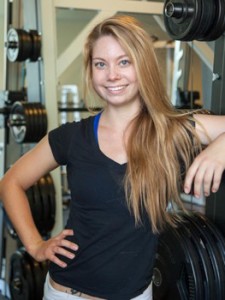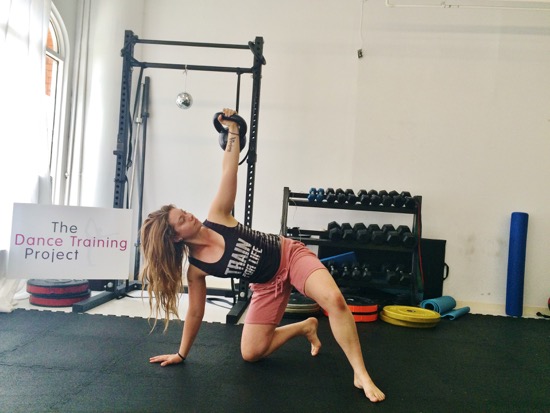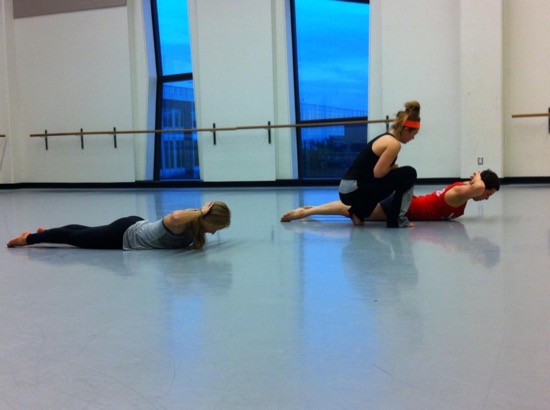Interview by Laura Donnelly

Monika Volkmar, is the creator of the Dance Stronger multi-media strength training resource for dancers. She is a graduate of the Ryerson University dance program and certified through the National Strength and Conditioning Association (NSCA) as a strength and conditioning specialist (CSCS). She is also a level 2 NeuroKinetic Therapy practitioner, Functional Movement Screen (FMS) certified, and a Thai massage therapist and teacher. Most recently Monika completed Anatomy in Motion training with Gary Ward.
After a series of injuries forced Monika to stop dancing, she became immersed in strength and conditioning, injury prevention, movement training, and Thai massage. As she studied then explored and incorporated new knowledge into her body, she healed herself. Realizing how much this information would have helped her “dance stronger” and avoid injuries when she was studying dance, Monika created this program to help dancers who want to enhance their technique and physical performance while minimizing soreness and injuries.
I met Monika online. I was searching for information on the necessity of building strength simultaneously with flexibility for my dance students. I found Monika’s article Stretches You Need to Stop Doing. It contained information I used that day in class. It worked so well that I bookmarked her blog and signed up to receive new articles from her.
In the summer of 2015, Monika issued a call for beta-testers for her Dance Stronger Program. She wanted a diverse group of people from current students and dancers, to older dancers, and dance teachers who would document their process as they went through the program. I volunteered and was excited to be part of the group. I’m no longer performing but need to stay strong and healthy to teach well. More importantly, I feel this work allows me to give my dancers information that helps them dance better, longer and with fewer injuries.
I interviewed Monika on Feb. 2, 2016.
LD: On your blog you often share your learning adventures, when you attend a new training, read a good book, or discover something in your own body through your personal movement practice. Please share some of your thoughts about life-long learning.
MV: Personally, what motivates me is always learning something new. Attending seminars reignites passion for what I’m doing. When I’m not learning anything I’m not as motivated by what I’m doing. Also, I think it’s good to keep up with what is on the “cutting edge”, learning what others in the industry are studying to best experiment with what works and what doesn’t.
I first got into this field (strength and conditioning, movement training and injury prevention) to learn how to help myself. Teaching what you’ve learned is a great way to solidify it in yourself. Seeing what I’ve learned applied in other people’s bodies, helps me to understand it for myself and for other people.
If you haven’t experienced something you don’t really know it, you only know what you can feel, and you can only see what you know, which makes it extremely important to first feel in your body what you wish to teach–try to understand it from the inside out to avoid conveying “corrupted” information. You can read all the research on something, and have the theoretical understanding, but you don’t really know that thing until you’ve felt it happen in your own body, and then have applied that to others and seen how it works in their bodies. I like when evidence and scientific research backs up experience.
LD: Will you speak about your commitment to help dancers be stronger and healthier?
MV: What inspired me to create Dance Stronger is that I’ve experienced so many injuries myself.
If I had known “then” what I know now, I think I could have minimized the stuff that I went through. If I had known important concepts like breathing and how it supports your strength, and recovery from injuries it would have been very helpful.
If I had known about how to manage my stress levels and how to recover, and if I had had a teacher that really promoted more biomechanically sound practices and was a bit more encouraging, I think that might have helped.
The biggest issue wasn’t that I was doing things in dance that were unsafe, because generally I didn’t try to do crazy tricks, like some other dancers who do a lot of excessive stretching and risky moves. I was definitely stretching more than I should have been, as many of my injuries were overstretching based, but even with all that, I truly feel that if I’d been in a bit better place mentally, and was a bit more grounded in who I was … I don’t know, there are so many factors correlating to injury in dance.
Definitely, if I’d been wiser in my practices, both in and out of class, it would have minimized my injuries.
LD: I saw from a recent blog post that you have just completed the Anatomy in Motion Immersion course. Please share how you think the AiM work will influence your work.
MV: In both the book portion and the Dance Stronger movement program there are things I want to update. I’d like to find a better way to convey this new information.
For example, I have learned things about foot function and I want to include those.
I hope to add some of the AiM exercises that have the potential to create some impressive differences in your body into the Dance Stronger program.
It’s challenging to figure out how to communicate the Anatomy in Motion concepts in detail without being there in person to ensure that people understand how the movements should feel.
It’s difficult doing this online. I want to give everyone as much information as possible so they can make the best-informed choices, but realize there are limits and challenges working with this medium.

LD: When did you start Dance Stronger?
MV: The 2012 version of Dance Stronger was my first attempt at making an online program with videos. I created them soon after I started my blog The Dance Training Project. There wasn’t much instruction, there was no explanation of the “why” for the selection of exercises. There were really no explanations, except for some guidelines about how to follow the program, like how to progress with the weights. It was primarily gym equipment based, not much body weight stuff.
LD: Why did you want to make a second version of the program?
MV: A lot of the feedback I got from the first program was from people who didn’t have access to a gym. They wanted a program that they could do at home without expensive equipment.
Dance Stronger is more about getting to know your body, moving like a human being, and developing a basic level of strength, not just a strength training program. Based on this clarification of the Dance Stronger goals and the feedback I got, I wanted to add a home training program. I wanted it to empower people to develop strength using their own body weight, on the “dancer’s budget”. I was continuing to read and learn new things that I wanted to add to the program, which was becoming outdated.
For Dance Stronger v2 I decided it would be more beneficial to speak through the videos to give information and guidance to participants while they watched me complete the exercises.
LD: How did you develop the second version of Dance Stronger?
MV: I decided to ask for volunteers to do a beta test of the material. At first, I was thinking I would make a program similar to the first version just with better quality videos.
As we started, I realized I felt strongly that it was necessary to give more background information about the approach and the exercises for the home program to work. That is how the book developed. I started writing guidelines and it turned into a whole different entity, much bigger than I intended it be.
As part of the trial people received the material in sections as I wrote the chapters and filmed the videos. The program developed naturally and I was able to make adjustments as I got feedback from participants as they completed the sections.
LD: What were your goals for Dance Stronger v2?
MV: The selection of exercises in the program came from the commitment I finally made to myself to explore the exercises that I myself had been assigned over several years. Exercises that I had learned and done for a short period of time but hadn’t really explored or investigated to their full potential. I gave myself time to discover many levels to these exercises in myself and with my clients, and with this basis I was confident in creating the Dance Stronger program.
Making this commitment to myself gave me more information and experiential knowledge to share. I felt I had learned something that would be valuable for other dancers, and I would able to translate this into a method for people to experience their bodies, noticing how they feel, move, and change. Dance Stronger is a way for me to share that cross-training for dance is about more than “exercise”, not just completing a lot of reps without paying attention, but is about the body learning new ways of moving.
Another goal for Dance Stronger was to make the program as customizable as possible and to give enough information so people could make the best choices they could for their bodies. We will often experience things that are not comfortable in our bodies when attempting to make a change. My goal was to encourage participants to simply observe and explore these feelings of discomfort, within reason, trusting they are on the way to a state of more balance and freedom.

LD: What were some of the results from the summer trial?
MV: It blew me away that people got the results they did. I was hoping that by making the program customizable that it would work for a variety of people, but still, I was not expecting anyone to get as much out of it as they did.
There were all different types of dancers participating – belly dancers, current contemporary dancers, tango dancers, ballet dancers, and non-dancers–the youngest girl was 13, oldest gentleman was 70.
I got data on how the program works for different ages. As people got stronger, they reported improvements in the execution of their chosen dance styles. Some people discovered underlying issues in their bodies they needed to address, others experienced relief of long-term pain.
I found out that the program helps people who are already involved in fitness and working out to understand their bodies better. One participant was already a strength & conditioning coach who works with dancers. She was very open and contributed to the group. It became a nice collaboration.
LD: What made you think of running the trial through Facebook?
MV: I was reading a book by Amanda Palmer The Art of Asking – how she was able to connect and interact with her followers on Facebook. It made me think ‘Am I really, truly interacting with the people that read my blog and follow me? Am I really considering them to be real people?’
When you consider that everyone you interact with online is a “real” person it makes you want to interact with them more deeply, and I realized that if I asked a few more questions, we might develop more important relationships, they could change my life and I could change theirs. The idea of having a community that cares about each other became important to me. I wanted to see if bringing people together through Dance Stronger would have a positive impact. Everyone I’ve met online and through my blog has been great, imagine them all “playing” and sharing experiences together as a group.
The trial group used the Facebook group more than people currently going through the program. There were lots of questions and answers through the trial. It was a good way to stay in touch since people moved through the program at different speeds and lived in different time-zones.
LD: What’s you vision for how Dance Stronger will grow?
MV: I think I will continue to revise the program as I learn new things. I’d like to develop a physical book about Dance Stronger within the next few years. I’d also like to create a Dance Stronger training program for dance teachers, fitness professionals who work with dancers, and dancers who want to learn to take better care of themselves.
I see Dance Stronger as a never-ending process–constantly adapting based on my experiences and those of the participants. I like to say that it is more than a book and a program, it’s a journey we are taking together, learning together. If the dance industry is slow to change to incorporate strength training as a standard, I want Dance Stronger to be a hub online for all dancers to have access to this information.
LD: Is there anything else you’d like to share?
MV: I find it fascinating to see dancers go through their own process of experiencing their bodies and transforming how they move and think. For example, many dancers are so used to hypermobility that they have accepted this “functional dysfunction” as normal and unchangeable. With overuse what was functional dysfunction can start to produce pain. Chronic pain creates a state of normal that is a basic fight or flight feeling in the body. People with chronic pain need a new normal–but releasing the pain and changing the norm creates such a different feeling in the body that this can actually create stress of a different kind. This is part of why change is hard… Something I discuss in a section of Dance Stronger.
I think it’s important to recognize that it’s not dancing that’s hurting dancers but the way that they’re doing it. Part of my mission is to teach dancers how to balance and strengthen their bodies to minimize pain, and to help them discover new ways to do their dance steps that prevents re-injury.
Dance Stronger is a re-education program. Change the way you think about technique and cross-training for dance, and dare to try what might be the opposite of what you believe to be the “best” way of doing things, or the ways you’ve always done them. All I can really hope to do is give people some tools to balance their hypermobility and learned compensatory strategies and encourage them to take time to listen to their bodies so they are able to dance stronger.
Resources and links:
Dance Stronger Program: http://dancestronger.com/
The Dance Training Project: http://danceproject.ca/welcome/#.VlfMbd-rRyc
Monika’s article about the AiM training: http://danceproject.ca/how-training-human-movement-rather-than-dancing-more-can-improve-your-dancing/#.VlfFad-rRyd

Laura Donnelly, MFA, is a choreographer, teacher, and dancer who writes and creates community based public art involving visual and word art. She directs Dancing with Ease presenting workshops for teachers and students incorporating the Alexander Technique into teaching, studying, and performing in dance, music, theatre, and life. Dancing Words encompasses Laura’s writing/editing/marketing consulting work.
A former professor of dance Donnelly’s research includes pedagogy, oral tradition in dance, collaborative process, music for dance, and the Alexander Technique. Her article Dance Technique – a Basis for Lifelong Learning appeared in the Chinese/English magazine All in One. Donnelly’s essay Meditation in the Dance Studio is published in Teaching with Joy: Educational Practices for the Twenty-First Century, Rowman & Littlefield Publishers.





Thank you so much for the opportunity to be featured here! 🙂 and thank you Laura for being so amazing, as always. Was great to chat with you for this interview, and i am grateful for your continuous encouragement and insights. I really appreciatiate you and i know your students are so lucky to have you 🙂
Happy to feature you Monika, thank you for the interview. And thank you to Laura for suggesting it and taking the time to talk with you about your work!